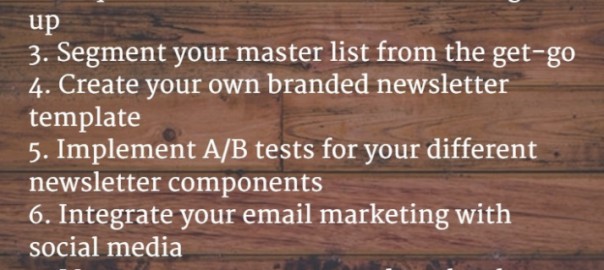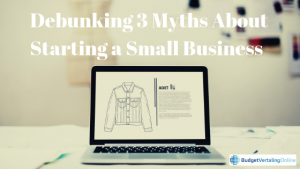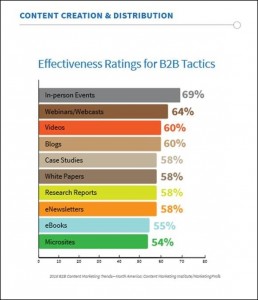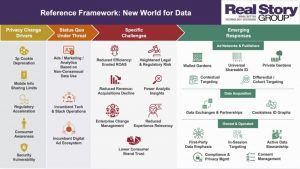You have a blog or newsletter. You want to start an email marketing campaign but don’t want to waste your efforts or resources.
When you start using email marketing for your blog or business, you need to stay on the right track from the very beginning to earn the highest ROI.

It’s my mission to help you make the most out of your campaigns so that you are successful in reaching your own goals.
Consider these 7 steps for getting started with email marketing in the most effective and efficient way possible.
———
1) Offer a double opt-in subscription
Although there are convincing arguments for and against this feature, a double opt-in for subscribers has the potential to help you.
The double opt-in means subscribers need to take an extra step and confirm their interest via email. This does have the potential of pushing people away, but it also dramatically improves the quality of your email list.
When people follow the double opt-in, they show extra interest in your emails and are more likely to engage with them.

They’re also less likely to unsubscribe.
This feature can mean fewer subscribers, but the list quality and end results may prove it’s worth it.
Need further convincing? Check out this GetResponse article:
New Research in the Epic Battle Between Double and Single Opt-in
2) Request additional information during sign-up
As another controversial feature, adding extra fields to your sign-up form has its pros and cons, but depending on your needs, having that extra information can really benefit your email marketing.
Some of the common extra fields I’ve seen are:
- Job title/function
- Company
- Industry
- Interest in further contact
- Offer to sign up to newsletter
I don’t often see these extra fields unless I’m trying to download a free resource, such as an eBook.
Having extra fields doesn’t really work unless you’re offering something of value in return.

Similar to the double opt-in, the people who fill out these additional fields show extra interest in what you have to offer. Your list quality will improve both with engagement and with list segmentation capabilities (see #3 below).
3) Segment your master list from the get-go
From your very first subscriber, you should have a plan in place for list segmentation.

The options are endless for how to do this. You can segment by industry, location or even behavior, such as where they chose to sign up.
When you segment your lists, you offer your subscribers a more personalized email experience. This has proven to improve open rates and the click-through rates on your call-to-action.
Instead of sending out generic, potentially inaccurate emails to everyone on your list, invest the time and resources you need to create a more personal experience for them via list segmentation.
Looking to learn more about this subject? Check out this article by Neil Patel:
How to Use Email Segmentation to Increase Your Conversion Rate
4) Create your own branded newsletter template
Many email marketing providers offer handy, premade templates with everything you need ready to go. Sometimes, this can be exactly what you need, but if you want to look more professional and legitimate, you need to create your own branded newsletter.
This can mean adding your logo, your website color scheme, or other recognizable elements.
Your template should, at minimum, have these elements:
- Baseline design elements, such as formatting and imagery
- Blank fields for content
- The required anti-spam elements
- Ideally, links to your social media accounts and share links
When you use a consistent, branded newsletter template, your subscribers will come to trust you and expect your emails. Your open rates may increase over time as a result.

5) Implement A/B tests for your different newsletter components
I’ve discussed this briefly in a previous article (Email Marketing Newsletters: Your Testing Checklist).
You’re not going to know what works best in your email marketing if you don’t test the different approaches first.
A/B testing is an essential element to all of your email campaigns and should be practiced every time to reap the most rewards.

Some examples of elements to test are:
- Subject line
- Layout
- Imagery
- Call-to-action
When you implement A/B testing in your email campaigns, you guarantee a clearer picture as to what approach you take works and what needs to change. This will help you create more successful emails in the future for a higher open rate, click-through rate, and higher overall ROI.
Interested in learning more? Check out this article by Kissmetrics:
A Beginner’s Guide to A/B Testing: Email Campaigns That Convert
6) Integrate your email marketing with social media
Although they may seem like entirely different worlds from each other, email marketing and social media can and should work together.
By joining forces, the two platforms give each other a boost in engagement and list building. Both platforms benefit.

It’s a win-win situation, so you don’t want to miss out on this opportunity by keeping the two services separate.
Looking for more information on this topic? Check out this article by Reachmail:
Benefits of Integrating Your Email and Social Media Strategies
7) Measure your outcome and apply what you learn
Perhaps the most important part of your email marketing activity, measurement is essential to determining whether what you’re doing is working and how it’s affecting the bottom line.
By measuring your email campaigns, you discover the elements that work and areas that need improvement, leading you towards a higher ROI and reaching your goals.
When you see what hasn’t worked, use that information to improve your future campaigns. It’s crucial to not only measure your results but also implement what you learn in future campaigns.

Want to know more about how and what to measure? Check out this article by HubSpot:
Your Complete Guide to Measuring Email Marketing Success
———
Now that you know these 7 tips, it’s time to act on them. Use them to your advantage and reap the rewards you’re looking for.
Here’s a quick recap of what was covered:
- Offer a double opt-in subscription
- Request additional information at sign-up
- Segment your master list from the get-go
- Create your own branded newsletter template
- Implement A/B tests for your different newsletter components
- Integrate your email marketing with social media
- Measure your outcome and apply what you learn

(58)







